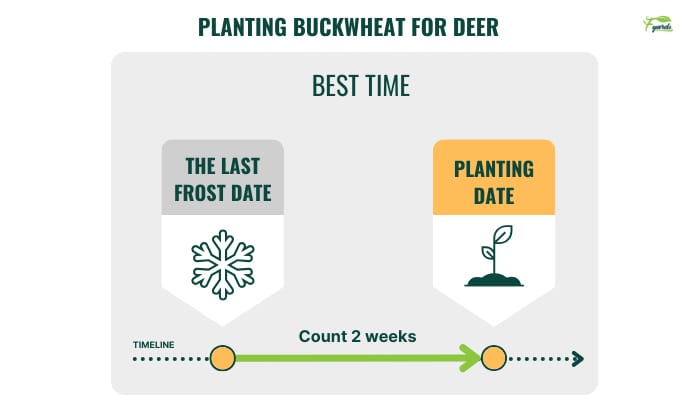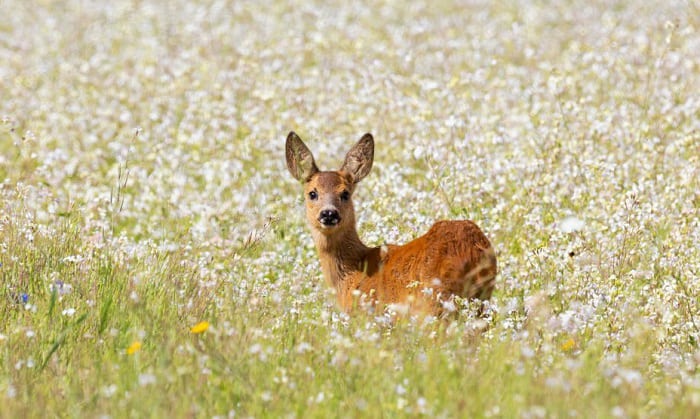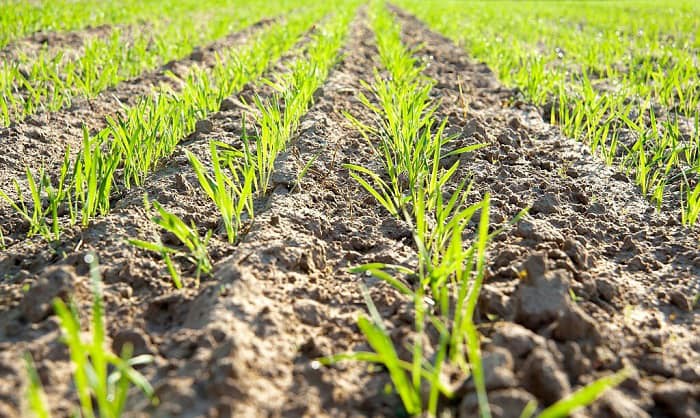Buckwheat is a good crop for attracting deer, turkeys, pheasants, and doves. It has high drought tolerance and will grow in pretty much all soil types, making it beneficial for converting infertile logging decks into new food plots.
If your concern is when to plant buckwheat for deer, April to July in the north and May to August in the south should work well. Read below for more tips on planting this warm-season annual.
Table of Contents
Best Time to Plant Buckwheat for Deer
The best time to grow buckwheat for food plots is two weeks after the last frost, when the soil has thawed, up until late summer.
As for why, this annual plant doesn’t tolerate freezing weather well, and is often grown as a summer wildlife food source only.
People usually terminate it by October and November to make space for other crops like winter rye, clover, and radishes. The reason for this practice is that buckwheat will either be grazed off or eaten by deer as August or September approaches.
If you want a food plot in late fall or winter, it’s necessary to kill off buckwheat so that other crops can grow, or the plant will end up dying once frost arrives anyway. In the latter case, you’ll be left with no forage for the hunting season.
So, remember these basic rules regarding your buckwheat crop planting dates:
- Plant buckwheat up until August, or seven to nine weeks before starting a fall crop.
- If you let your buckwheat go to seed, the seeds may sprout and compete with your new plants. They will also reduce the amount of phosphorus available to your soil.
For this reason, mow and disc the buckwheat to terminate it in the fall.
- Make sure to do this task 1.5 weeks after flowers appear as well.
Here is the time to grow buckwheat from seed for several states in the US:
- In North Carolina – May 1 to June 15
- In Missouri – May 8 to late August
- In Georgia – April 15 to June 15
- In Michigan – Late May or early June
Buckwheat Planting Tips for Deer
If you’ve already picked a buckwheat planting time, take note of the following guidelines to grow buckwheat seed for deer.
- Seeding rate
How much buckwheat per acre to plant depends on whether you’re growing it alone or in a food plot mix.
For the latter option, just follow the direction of the seeding package. When sowing buckwheat alone, 50 pounds or 30 pounds of seeds per acre will do—more if you’re broadcasting and less if you’re drilling them.
- Till or no till buckwheat planting
Traditional instructions involve disking or tilling the ground prior to planting forage. However, you can forgo tilling by applying glyphosate to the soil at a rate of two quarts per acre three times in the spring.
Each application should be four weeks apart from each other, and once this is taken care of, the buckwheat food plot seed can go into the soil at a depth of 0.5 to 2 inches.
As for termination, simply knock down the buckwheat using an ATV cultipacker, then apply glyphosate again, following the same rate as the pre-planting instruction. This measure will break down the buckwheat to make way for your new forage.
What is the Soil Requirement for Buckwheat?
You should sow buckwheat somewhere with a pH of 5.5 to 6.0. Conduct a soil test and follow its fertilizer recommendations, or apply a 5-10-15 formula to establish an entirely new food plot.
Buckwheat is low-maintenance, but it grows best in mediums that are moist and well-drained, with a temperature of 45 to 75℉, and at least six hours of sunlight.
Conclusion
We hope this article helped you determine when to plant buckwheat for deer.
Buckwheat excels in increasing organic matter content and controlling weeds in the soil, so they should be your first choice of forage when gardening in the spring and summer.
So, order that bag of seeds if you still have time to plant! We wish you success in cultivating your new food plot.
Read more:

Hi, I am William – Floridayards’ digital content creator. My job is to find answers to all your concerns with thorough research and our team’s expert advice. I will also bring you honest reviews on the best products and equipment for raising your beautiful garden. Please look forward to our work!














